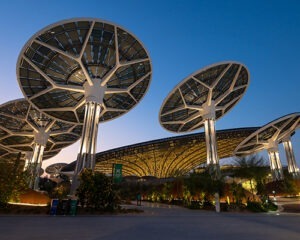Impact XM shares seven sustainable action areas for planning green meetings
Global event and experiential marketing agency Impact XM believes that sustainability is not an end goal, but a practice. As part of its efforts to educate its employees, clients and industry, the company created a list of seven sustainable action areas. As Impact XM works towards these goals internally, it hopes the list will help other companies in making their own practices greener.
Smart Meetings spoke with Heather Griffin, vice president of marketing at Impact XM, to learn more.

Sustainability has always been important to Griffin in her personal life, but over the past few years, she’s found it increasingly vital that the companies she has worked for are being conscientious too. Impact XM, she explains, has been committed to improving in this area for a long time, and with rising demand and awareness of sustainability, the company’s efforts have grown.
The rating company EcoVadis annually assesses Impact XM’s labor, human rights, DEI and environmental practices as a guideline for improving performance in all of these areas. Impact XM also recently began disclosing environmental data through CDP, a non-profit that runs the global environmental disclosure system. CDP allows a company, city or region to track its environmental impact by self-reporting everything from waste management to CO2 production.
Read More: Better Than Before
What is Sustainability to You?
Griffin suggests a carbon accounting tool should be applied companywide. Carbon produced by an event is only one small part of what should be tracked, and the tool may be too large of an investment for just one event. However, when you’re searching for partners for your upcoming event, it’s helpful to ask if they use one. If so, it likely can help you predict the carbon impact your event would have. Together, you can come up with solutions to decrease it.
To get started, determine what your company’s sustainability goals are. You don’t have to meet every single one. Think about waste management and DEI—remember that sustainability isn’t just environmental. Once you determine which areas within sustainability are most important to your company, then you can research the right tools to support you in tracking it and find ways to reduce or offset it.
In Smart Meeting’s ongoing journey to inspire meeting professionals with the latest tips for elevating the event design process, we worked with the AI app InVideo to bring our content to visual life and allow all viewers to accessibly enjoy content in video form. We hope you enjoy. Please consider following our YouTube channel for more weekly tips and trends for meeting planners.
One client came to Griffin with the goal of improving conservation efforts. From there, Griffin and the client broke it down even further: what type of conservation? Plastic? Energy? This is the time for the client in the example to look at the spending base—as in, how much water does an event use? How much of that water usage is unnecessary? The company can then develop a plan to cut back.
The Seven Sustainable Action Areas, Explained
Griffin explained that Impact XM’s seven action areas were driven by the United Nation’s 17 Sustainable Development Goals (SDGs). “When you see 17, you feel like you can’t take it all on. You don’t want to look at the full picture right off the bat because it can be overwhelming. The seven action areas can help you start to organize and think about the steps you could take. We can do parts—you’ll be surprised by what little things you can do that can make an impact.”
An interesting detail about both the UN SDGs and Impact XM’s action areas is that crossover is almost inescapable. “There are a lot of areas,” she says. “We are trying to organize it to help event planners think about just seven. It allows you to see that conservation is going to help with water, and at the same time it’s going to help with land…we’re trying to find ways to get everyone started.” As you read on, think about how many action areas just one sustainable step could fit into. You’ll be pleasantly surprised to find that most steps apply to many action areas at once.
1. Conservation: Power and Natural Resources

Conservation is all about reducing how much you use of any resource.
This is one of the areas where a carbon accounting tool can be incredibly useful. A partner who uses one can show you what impacts your event would have. For example, Griffin says, “If you’re focused on CO2 reduction for attendees coming to your event, there are partners out there that would actually track through, for example, a registration site, identify where attendees are coming from and where they’re going, what form of transportation they are taking. By doing that, they can figure out ways to offset it directly with the attendees.”
Read More: Green Airports
2. Innovation: Industry Infrastructure, Materials and Logistics
Close in line with the former action area is the innovation in materials and processes that do the work of conservation.
Does your event venue use an energy-efficient cooling system? What about automated lighting? The Oregon Convention Center did just this in its recent renovation by installing LED lighting that automatically brightens or dims based on the amount of natural light in the room at any given time.
Consider if your production partner uses more environmentally conscious materials when building assets for your event. Have you thought about the size of the displays you need? Are they standard widths? Designing to be sustainable can mean making sure you do not need an oversized piece of material that can cause excess amounts of waste.
Read More: Water From Thin Air
3. Waste Reduction: Production to Consumption
When it comes to waste reduction, think of gifting: by the time materials have been gathered, the gift has been produced, packaged, shipped to your event and given to the attendee, it’s gone through multiple steps of the supply chain. Now multiply that by every attendee.

Wow, that’s a lot of plastic.
But it doesn’t need to be. Planners don’t have control over every area of the production line, but they do have the power to look into the companies that are part of it. Griffin says that many of Impact XM’s clients ask about supply chain in their RFPs. For example, does a company have a donation program for leftover materials?
Locally sourced gifts are even better—by making the production chain smaller and more local, you reduce the level of emissions you’re contributing to by reducing how far you need to ship materials or gifts.
4. Sustainable Cities and Communities: Transportation, Climate and Emissions
The location you choose to host your event makes a major difference in countless areas. An event venue’s sustainable practices aren’t the limit—look to the surrounding area too. Some cities, such as Miami Beach, even have building codes that require all new public projects to have LEED Silver certification.
When your attendees are concentrated in a certain region, you have the opportunity to reduce the emissions that would be produced through every attendee’s travel by choosing a location that is closer to them. As a bonus, an easier travel experience is likely to produce higher attendance.
Read More: Secrets of Green Miami
5. Health, Wellness and Equality: Accessibility and DEI
Just as you look into a facility’s waste management, cooling systems and other processes that reduce waste, you can look into their employment practices. Research the company. Review news stories that mention them. What employee benefits do they offer? What recent initiatives have they taken part in? Look for fair wages and a diverse staff.
When it comes to your attendees, accessibility is key. IBCCES (The International Board of Credentialing and Education Standards) offers a search registry where you can find out if the city, hotel or venue where you’re hosting your event is a Certified Autism Center (CAC) or a Board Certified Cognitive Center (BCCC). More cities and businesses are attaining this seal of approval, which assesses if its staff is fully equipped and trained to meet the needs of individuals with autism, ADHD, anxiety and many more cognitive or mental health differences that benefit from specialized accommodations.
6. Partners and Platform: Collaborative Efforts for Innovation
This action area is all about supporting local partners in the area where you host your meeting, particularly those that work to make their home more sustainable. Griffin shared one example of when Impact XM hosted an experience in Salt Lake City where they sourced a local compost farm to donate used compostable cups to after the event.

If you want to use locally sourced food in the meals at your meeting, not only are you helping to support the local economy and local farmers—you are also producing lower carbon emissions by reducing the amount of shipping it takes to transport ingredients, and reducing the possibility that some ingredients would go bad and be wasted as they are transported to the kitchen. Sounds like action area one…and three, doesn’t it?
Read More: The Overlooked RFP Asks That Could Save the Planet
7. Purpose and Commitment: Address Human, Social, Economic and Environmental Issues
If there’s any one piece of advice Griffin would say is the absolute number one, it’s to talk.
In recent years, as she’s worked with planners who want to be more sustainable, she says, she’s found that some express fears of “greenwashing”—that is, talking about sustainability, but not making many concrete efforts to be more sustainable. She says, “Don’t be afraid of greenwashing, because then you’re going to be on the green-hushing side. And this is a very welcoming period of time when we can have the conversation, ask the questions and share. Even if it’s small, you’re making steps. Be honest.”
It’s not about being perfect. We are human, and we simply don’t have control over everything. You probably won’t attain a net-zero event any time soon. That shouldn’t stop you from trying to cut waste where you can. You’re still making a difference and helping to move us towards where we want to be.
Sustainability is very much a communal journey. It requires the participation of everyone, from individuals to large companies, and every small step makes a difference. As we share our small steps, we’re inspiring others to do the same, and they are inspiring us to make sustainability efforts we wouldn’t have considered before.
Read More: Sustainable Meetings Through Renewable Concepts
The Big Lessons
“In our industry, there are some things that we can’t completely reduce, so we need to find ways to invest in the right type of offsetting,” says Griffin.
 In her experience, when a company she has worked for made efforts towards being more sustainable, she’s led with the question, “Could we move forward and find ways to become a better version of ourselves?”
In her experience, when a company she has worked for made efforts towards being more sustainable, she’s led with the question, “Could we move forward and find ways to become a better version of ourselves?”
Remember, Griffin says, “You’re not going to solve world hunger, but you can look at ways to support that sustainable development goal by looking at local food options, and you’re helping those local farmers and the hiring of individuals in the process. You could look at it in a lot of different ways. But you have to start with figuring out which direction you want to go. Eventually, it all balances out.” The seven sustainable action areas are a great place to start making your plan.




